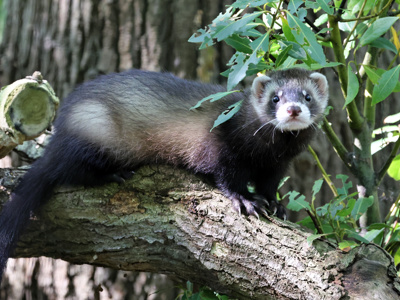
European Polecat
Mustela putorius
Although present across Wales, much of England, and parts of Scotland, polecats are elusive and not often seen.
Polecats are carnivores and members of the mustelid family. They have long, slim bodies and their fur is generally dark in colour, but a paler underfur gives the body a slightly lighter appearance. Their most distinguishable feature is its facial markings, making it seem as though they are wearing a bandit mask around their eyes.
Behaviour
Much less territorial than other mustelids, with animals of the same sex often sharing their home ranges, and these territories vary in size depending on habitat and food abundance.
Territory borders are marked and defended with piles of scats with a pungent repellent scent. They use dens, normally in rabbit burrows. In winter when the weather is harsher, they are known to den in hay bales, under shed and in rubbish tips.
When hunting, they have been known to paralyse their prey in order to store, keep fresh and consume later.
UK Status
The polecat declined as a result of historical predator control and persecution. They suffered massive declines in the 19th century, leaving the population toa mere 5000 individuals mainly restricted to Wales.
There have been a number of reintroductions in the 1970s and 80s, which has resulted in population increases within the UK. The polecat is consequently protected under the Wildlife and Countryside Act (1981) and was added to the list of UK Biodiversity Action Plan (BAP) mammals in 2007; a status that offers protection and conservation plans in order to halt or reverse their decline.
Threats
The drastic declines polecats suffered in the 19th century, which almost led to their extermination within the UK, was down to hunting for their furs and predator persecution by game keepers. The wide scale reduction in hedgerows within the UK is also effecting population recovery.
There is also evidence that prey numbers greatly effect polecat numbers, especially when disease epidemics like myxomatosis in rabbits occur. Introduced predators such as American mink have been shown to drive declines in numbers of polecats. Hybridisation with wild-living domestic ferrets, vehicle collisions on roads, and secondary rodenticide poisoning are also current threats to polecats.

Distribution
Wide European distribution, Ural Mountains in Russia being the easternmost boundary of their range. Absent from Ireland, northern Scandinavia and the Balkans. Also found in Morocco (northern Africa).
Habitat
Wide variety of habitats across its range. Do well in woodlands, farmlands, grasslands, forest edges, urban areas and gardens, as well as sand dunes and marshes. Tend to avoid mountainous regions. Preference for farmland with hedgerows and woodland edges.
Diet
For most populations, rabbits are an important food source for polecats, particularly in summer. They are slender enough to chase rabbits into their warrens to catch them, so are specialised to underground predation. However, they are a generalist predator, and will readily eat rodents (from rats to voles), amphibians, birds and even carrion.
Wildwood inside information
In our Kent park, the polecats are alongisde the badger enclosure. If they are not out playing, you can see them asleep together in their dens.
Family facts
Ancestors of the domestic ferret. Domesticated over 2000 years ago to hunt animals classed as “vermin” (rabbits and rats).



